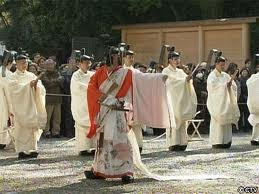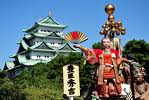. Aichi Prefecture - Festivals .
. Atsuta Shrine Legends .
:::::::::::::::::::::::::::::::::::::::::::::::::::::::::::::::::::::::::::::::::::::::::::::::::::
Atsuta Shrine Festivals
***** Location: Nagoya
***** Season: See below
***** Category: Observance
*****************************
Explanation
quote
Atsuta Shrine (熱田神宮, Atsuta-jingū)
is a Shinto shrine traditionally believed to have been established during the reign of Emperor Keikō (71-130) located in Atsuta-ku, Nagoya, Aichi Prefecture in Japan.
The shrine is familiarly known as Atsuta-Sama (Venerable Atsuta) or simply as Miya (the Shrine). Since ancient times, it has been especially revered, ranking with the Great Shrine of Ise.
The Kojiki explains that Atsuta Shingu Shrine was originally founded to house the imperial treasure sword,
Kusanagi no Tsurugi 草薙の剣 .
According to traditional sources, Yamato Takeru died in the 43rd year of Emperor Keiko's reign (景行天皇43年). The possessions of the dead prince were gathered together along with the sword Kusanagi; and his widow venerated his memory in a shrine at her home. Sometime later, these relics and the sacred sword were moved to the current location of the Atsuta Shrine. Nihonshoki explains that this move occurred in the 51st year of Keiko's reign, but shrine tradition also dates this event in the 1st year of Emperor Chūai's reign.
From 1872 through 1946, the Kasuga Shrine was officially designated one of the Kanpei-taisha (官幣大社), meaning that it stood in the first rank of government supported shrines.
This Shinto shrine is dedicated to the veneration of Atsuta-no-Ōokami. Also enshrined are the "Five Great Gods of Atsuta", all of whom are connected with the legendary narratives of the sacred sword --
Amaterasu-Ōomikami,
Takehaya Susanoo-no-mikoto,
Yamato Takeru-no-mikoto,
Miyasu-hime no-mikoto, and
Take Inadane-no-mikoto.

Over 70 ceremonies and festivals are held annually at the shrine.
Hatsu-Ebisu (January 5):
Seeking good fortune in the new year from Ebisu, the God of Fortune.
Yodameshi Shinji (January 7):
The projected annual rainfall for the coming year is prophesized by measuring the amount of water in a pot kept underneath the floor of the Eastern Treasure House.
Touka Shinji (January 11):
see kigo below
Hosha Shinji (January 15):
Ceremony which involves shooting an arrow at a wooden piece called chigi fixed at the center of a huge mark.
Bugaku Shinji (May 1):
A ceremonial dance from the Heian era is performed outdoors on a red painted stage.
Eyoudo Shinji (May 4):
A festival to commemorate the return of the sacred sword in the reign of Emperor Tenji.
Shinyo-Togyo Shinji (May 5):
A festival in which portable shrine (mikoshi) is carried in a formal procession to the Western Gate, where ceremonies and prayers for the security of the Imperial Palace are performed in the open air.
In the Meiji period and Taisho period, this procession moved in sober and solemn silence. The ceremony at the gate was brief, lasting only 20 minutes; and then the mikoshi and its attendants returned into the Shrine precincts. Shogun Ashikaga Yoshimasa provided a new mikoshi and a complete set of robes and other accouterments for this festival on the occasion of repairs to the shrine in the 1457-1459 (Chōroku 1-3).
Rei Sai (June 5):
see kigo below
© More in the WIKIPEDIA !
kencha sai 献茶際 tea offering ceremony
kenka sai 献花祭 flower offering ceremony
:::::::::::::::::::::::::::::::::::::::::::::::::::::::::::::::::::::::::::::::::::::::::::::::::::
kigo for mid-summer
Atsuta matsuri 熱田祭 (あつたまつり) Atsuta festival
shoobu matsuri 尚武祭(しょうぶまつり)"military arts festival"
..... shoobu e 尚武会(しょうぶえ)

makiwarabune 巻藁船(まきわらぶね)ships with lanterns
(makiwara is a roll of straw, used for practising Japanese archery. On the ships, this straw rolls are used to fix the lanterns.)
The main festival of this shrine, on June 5.
It used to be on the fifth day of the fifth lunar month, like the tango seasonal festival.
Portable tabernacles (mikoshi) in various styles are carried along the approaches to the shrine; many mikoshi are carried by children, who parade to the sound of drums and bamboo festival flutes.
At night, groups of 365 lanterns on huge boats (makiwarabune) float down the river and are then displayed at the East and West Gate of the shrine.
A firework lights the night sky too.
This festival commemorates an Imperial proclamation (semmyō) issued in 1872 (Meiji 5). After 1906 (Meiji 39), exhibitions of judo, fencing (kendo), and archery (kyudo) are presented for the gratification of the kami. Acrobats, artists and dancers join the parade and many stalls sell local specialities along the road.
:::::::::::::::::::::::::::::::::::::::::::::::::::::::::::::::::::::::::::::::::::::::::::::::::::
kigo for the New Year
Atsuta tooka shinji
熱田踏歌神事 (あつたとうかしんじ)
Atsuta shrine dance and song ceremony
January 11

A variation on an annual ceremony (Tooka no sechi-e) of the Imperial Court in the Heian period (10th-12th Century)
On this day, the shrine dance becomes a prayer in movement hoping for bumper crops of the year.
*****************************
Worldwide use
*****************************
Things found on the way
.Tooka Sechi-e 踏歌節会 Dance and song festival
at shrine Sumiyoshi Jinja in Osaka
A ritual of the same name is held on January 11 at Atsuta Jingu in Atsuta Ward, Nagoya.
.................................................................................
Miya Juku : Station Nr. 41 at the old Tokaido Road

Atsuta shinji (熱田神事) Atsuta Shrine Ceremony
woodblock by Hiroshige Utagawa
. . . CLICK here for more Photos !
quote
Miya-juku (宮宿, Miya-juku) was the forty-first of the fifty-three stations of the Tōkaidō. It is located in the Atsuta-ku section of the city of Nagoya, in Aichi Prefecture, Japan. It was six km from Narumi-juku, the preceding post station.
In addition to being a post station on the Tōkaidō, it was also part of the Minoji (a minor route which runs to Tarui-juku on the Nakasendō) and the Saya Kaidō 佐屋. As a result, it had the most hatago lodgings of any post station along the Tōkaidō, in addition to its two honjin main lodgings for feudal lords.
© More in the WIKIPEDIA !
. The 53 stations of the Tokaido 東海道五十三次 .
From Atsuta there were two possibilities to reach the next station, Kuwana.
One was via Saya and then by boat on the river Kisogawa 木曽川.
See Matsuo Basho below.
.................................................................................
FOOD served at Atsuta Jingu
. "Miya Kishimen 宮きしめん" Kishimen shrine noodles
. Fuji Dango 藤団子 Wisteria Dumplings
.................................................................................

Kiyomizu Sha 清水社 Kiyomizu Shrine
in the woods around 熱田神宮 Atsuta Jingu
Behind the shrine is the sacred spring, dedicated to
deity:
. Mizuha no me no kami 罔象女神 / 弥都波能売神 .
Mizuhanome ミヅハノメ
o shimizu お清水 sacred clear water
There was once a samurai with an eye disease. When he washed his eyes with this spring water, he got healed soon. ME no kami - 目 means eyes.
The water helps you obtain a beautiful skin if you wash your face with the spring water.
If you pour water on a stone in the spring with a dipper, hitting three times, your wish will come true.

. biyoo jisha 美容寺社 praying for beauty .
. Amulets for Eye Disease .
*****************************
HAIKU
Matsuo Basho visited here on his trip "Nozarashi Kiko" 野ざらし紀行.
He wrote
I went to Atsuta to worship.
The grounds of the shrine were utterly in ruins, the earthen wall collapsed and covered with clumps of weeds. In one place a rope marked the remains of a smaller shrine, in another was a stone with the name of a god now unworshipped. All around, mugwort and longing fern grew wild. Somehow the place drew my heart, more than if it had been splendidly maintained.
しのぶさへ枯て餅かふやどり哉
shinobu sae karete mochi kau yadori kana
even the fern of longing
is withered; buying rice-cakes
at an inn
Tr. Barnhill
This hokku has the cut marker KANA at the end of line 3.
even the shinobu fern has withered
and I buy mochi ricecakes
at the inn . . .
Tr. Gabi Greve
. WKD : shinobu, shinobugusa 忍ぶ草 Hare's-foot fern .
Davallia mariesii
kigo for all autumn
- - - - -
磨なをす鏡も清し雪の花
togi naosu kagami mo kiyoshi yuki no hana
togi-naosu kagami mo kiyoshi yuki no hana
freshly polished,
the sacred mirror too is clear:
blossoms of snow
Tr. Barnhill
Polished anew
the holy mirror too is clear–
blossoms of snow
Tr. Shirane

. shinkyoo 神鏡 the "divine mirror" .
They remind of the mikusa no kamudakara 三種の神器, sanshu no shingi, the famous three imperial regalia.
At the shrine in Atsuta, the sword Kusanagi (草薙劍, Kusanagi no Tsurugi) is kept and maybe a replica of the divine mirror Yata no Kagami 八咫鏡.
Basho's disciple in Atsuta :
. - Hayashi Tooyoo 桐葉 Hayashi Toyo - .
"Nozarashi Kiko" 野ざらし紀行
. Matsuo Basho 松尾芭蕉 - Archives of the WKD .
Saya Kaidoo 佐屋街道 The Saya Road
Atsuta Jingu 熱田神宮
Iwatsuka Shuku 岩塚宿
Manba Shuku 万場宿
Kamori Shuku 神守宿
Saya Shuku 佐屋宿
Kuwana Shuku 桑名宿

source : kaidolist/sayakaido
From Atsuta there were two possibilities to reach the next station of the Tokaido, Kuwana.
One was via Saya 佐屋 and then by boat on the river Kisogawa 木曽川.
Basho choose this road on his last trip to Kamigata.
He stayed at the home of Hermit Yamada 陰士山田 on the 25th day of the 5th lunar month in 1694 元禄7年5月25日. Together with other disciples they had a haikai meeting.
水鶏啼くと人のいへばや佐屋泊り
kuina naku to hito no ieba ya Saya domari
"the water rail calls there”
people say, and so
staying over at Saya
Tr. Barnhill
This is a greeting poem for his host Yamada.
The cut marker YA is at the end of line 2.

Now there is also a memorial mount with a stone of the Basho poem.
kuinazuka 水鶏塚(くいなつか)
:::::::::::::::::::::::::::::::::::::::::::::::::::::::::::::::::::::::::::::::::::::::::::::::::::

新緑の熱田に拝むばかりなり
shinryoku no Atsuta ni ogamu bakari nari
at Atsuta shrine
in all this fresh green
I can only pray
Yamamoto Shigeo
source : hitchhike.exblog.jp
*****************************
Related words
***** . WKD : Main Index
. Atsuta Shrine Legends .
BACK : Top of this Saijiki
[ . BACK to WORLDKIGO . TOP . ]
- #atsuta #shrine-
:::::::::::::::::::::::::::::::::::::::::::::::::::::::::::::::::::::::::::::::::::::::::::::::::::::



































